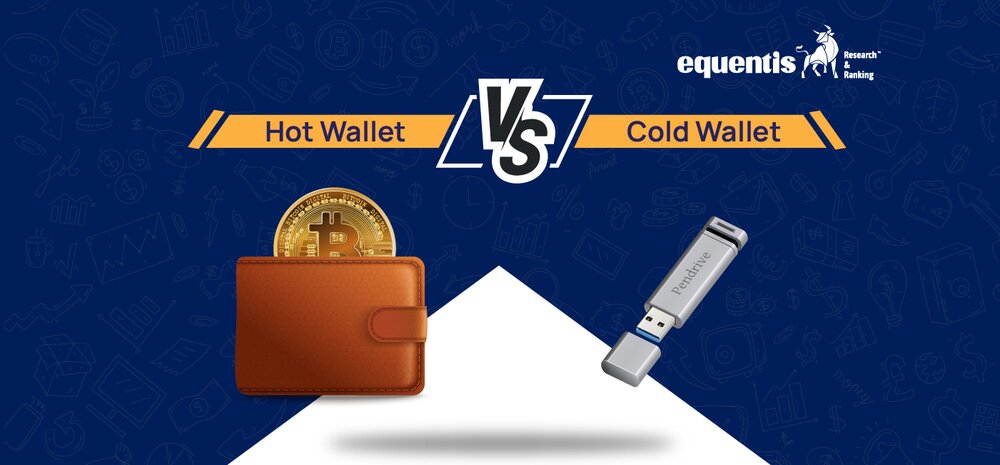Introduction
With the rise of digital assets, securing cryptocurrency has become a crucial concern for investors and traders. The risk of hacking, fraud, and cyberattacks has made it essential to choose the right storage method for safeguarding funds. The two primary options available are cold wallets and hot wallets, each offering unique advantages and security levels.
A hot wallet is connected to the internet, making it highly accessible but also more vulnerable to cyber threats. On the other hand, a cold wallet remains offline, ensuring maximum security but at the cost of convenience. Understanding the key differences between these wallets will help you make an informed decision on how to store your cryptocurrencies effectively. This article delves into their features, pros and cons, and best practices to enhance the safety of your digital assets.
What is a Hot Wallet?
A hot wallet is a cryptocurrency storage solution that is connected to the internet. These wallets are typically used for quick and frequent transactions. Some common types of hot wallets include:
- Web Wallets: Hosted by exchanges, allowing users to access their funds easily from anywhere.
- Mobile Wallets: Apps that enable users to store and trade crypto on their smartphones.
- Desktop Wallets: Software wallets that run on personal computers.
Hot wallets allow instant access to cryptocurrencies, making them convenient for day-to-day transactions. However, since they are always online, they are vulnerable to cyber threats.
Pros of Hot Wallets:
Easy to access and use for daily transactions: Hot wallets are designed for convenience, allowing users to quickly send and receive cryptocurrencies anytime, anywhere.
- Typically free to use: Most hot wallets are available for free, with no initial costs, making them accessible for all users.
- Integration with exchanges for seamless trading: Many hot wallets are directly connected to cryptocurrency exchanges, simplifying the process of buying, selling, and transferring assets.
- Supports multiple cryptocurrencies and tokens: Hot wallets often support a wide range of digital assets, allowing users to manage different cryptocurrencies within a single platform.
- Quick transfers and real-time updates on balance and transactions: Users can monitor their funds and execute transactions instantly, making hot wallets ideal for frequent trading and payments.
Cons of Hot Wallets:
- Higher risk of hacking, phishing, and malware attacks: Since hot wallets are connected to the internet, they are prime targets for cybercriminals who may attempt to steal funds through hacking, phishing scams, and malicious software.
- Dependent on internet connectivity: Transactions and access to funds require an internet connection, which can be inconvenient in areas with poor connectivity.
- Risk of losing funds if the wallet provider is compromised: If a web-based wallet service is hacked or shut down, users may lose access to their funds, especially if they do not control their private keys.
- Susceptible to social engineering attacks and user errors: Cybercriminals may trick users into revealing their login credentials or private keys through deceptive tactics, leading to financial losses.
What is a Cold Wallet?
A cold wallet is a cryptocurrency storage solution that remains offline, making it significantly more secure against online threats. Cold wallets are ideal for long-term storage of crypto assets. The main types of cold wallets include:
- Hardware Wallets: Physical devices that securely store private keys offline.
- Paper Wallets: A printed or written copy of private and public keys, usually generated using offline software to ensure maximum security.
- Air-Gapped Wallets: Offline computers or devices specifically used for signing cryptocurrency transactions without an internet connection.
Since cold wallets are not exposed to online threats, they are the preferred option for securing large amounts of cryptocurrency for long-term holding.
Pros of Cold Wallets:
- Highly secure from cyber threats, hacks, and malware: Since cold wallets operate offline, they are immune to online hacking attempts and malware infections.
- Private keys remain offline, reducing exposure to phishing attacks: Users have complete control over their private keys, ensuring that their funds are not susceptible to cyber theft.
- Ideal for long-term investors and large holdings: Cold wallets are best suited for investors who plan to hold cryptocurrency over an extended period without frequent transactions.
- Immune to exchange hacks and online fraud: Since cold wallets do not rely on online services, users are not affected by exchange hacks or fraudulent activities.
- Some hardware wallets offer multi-signature authentication for added security: Multi-signature authentication requires multiple approvals before executing transactions, adding an extra layer of protection.
Cons of Cold Wallets:
- Less convenient for frequent transactions: Transferring funds from a cold wallet requires additional steps, making it less practical for daily use.
- Requires careful handling to avoid loss or damage: If a cold wallet is lost, stolen, or physically damaged without a backup, the stored funds may become irrecoverable.
- Initial cost for hardware wallets can be high: Unlike hot wallets, hardware wallets often come with an upfront cost, which may not be ideal for users with a limited budget.
- Paper wallets can be lost or damaged if not stored properly: A paper wallet must be stored securely to prevent loss, fading, or destruction due to environmental factors.
- Transactions need to be signed offline, requiring extra steps: Users must manually transfer transaction data to an online system for execution, which can be time-consuming.
Key Differences Between Cold Wallets and Hot Wallets
The key differences are as follows:
| Feature | Hot Wallet | Cold Wallet |
| Internet Connection | Yes | No |
| Security LevelAccessibility | LowerHigh | HigherLow |
| Ideal For | Frequent Transactions | Long-term Storage |
| Risk of Hacking | High | Low |
| Cost | Usually Free | Can be Expensive |
| Recovery Options | Email/2FA backups | Seed phrases, offline backups |
| Convenience | High | Medium to Low |
Finding the Perfect Wallet
Your choice of wallet should align with how you manage and store your cryptocurrency.
- For frequent traders or those making regular payments, a hot wallet offers quick and easy access.
- If safeguarding your assets for the long term is the goal, a cold wallet provides the highest level of security.
- A smart strategy is to combine both—using a hot wallet for everyday use while keeping long-term investments safe in a cold wallet.
In conclusion, both hot wallets and cold wallets play a vital role in cryptocurrency storage, each catering to different needs. For optimal security, consider using a combination of both wallet types to balance convenience and protection.
Related Posts
Disclaimer Note: The securities quoted, if any, are for illustration only and are not recommendatory. This article is for education purposes only and shall not be considered as a recommendation or investment advice by Equentis – Research & Ranking. We will not be liable for any losses that may occur. Investments in the securities market are subject to market risks. Read all the related documents carefully before investing. Registration granted by SEBI, membership of BASL & the certification from NISM in no way guarantee the performance of the intermediary or provide any assurance of returns to investors.
FAQ
Which type of wallet is best for beginners?
For beginners, a hot wallet is the easiest to set up and use. However, for security, a combination of both hot and cold wallets is recommended.
Can I use both hot and cold wallets together?
Yes, many investors use hot wallets for daily transactions and cold wallets for long-term storage to balance convenience and security.
What happens if I lose my cold wallet?
If you have backed up your private keys or seed phrase, you can restore your wallet on another device. Without a backup, funds may be lost permanently.
Are hot wallets safe?
Hot wallets offer convenience but are susceptible to cyber threats. Using strong passwords, enabling two-factor authentication, and storing only small amounts can enhance security.
How often should I transfer funds to a cold wallet?
It depends on your needs, but transferring large amounts of cryptocurrency to a cold wallet periodically helps minimize risk.
How useful was this post?
Click on a star to rate it!
Average rating 5 / 5. Vote count: 1
No votes so far! Be the first to rate this post.
I’m Archana R. Chettiar, an experienced content creator with
an affinity for writing on personal finance and other financial content. I
love to write on equity investing, retirement, managing money, and more.
- Archana Chettiar




















